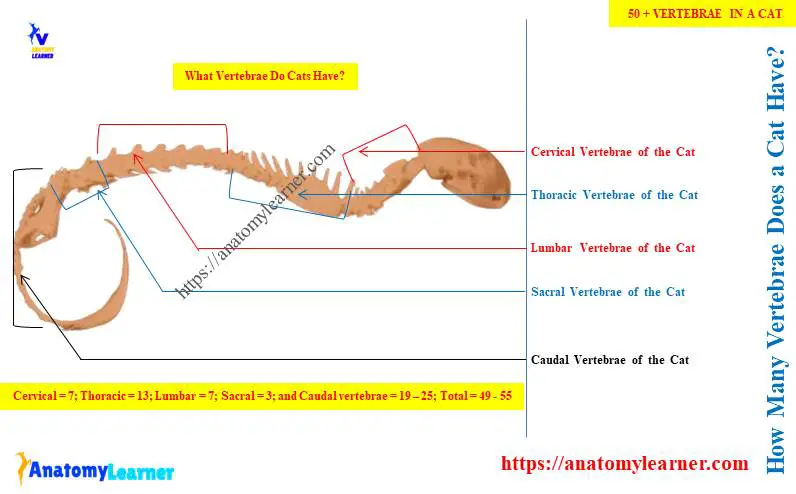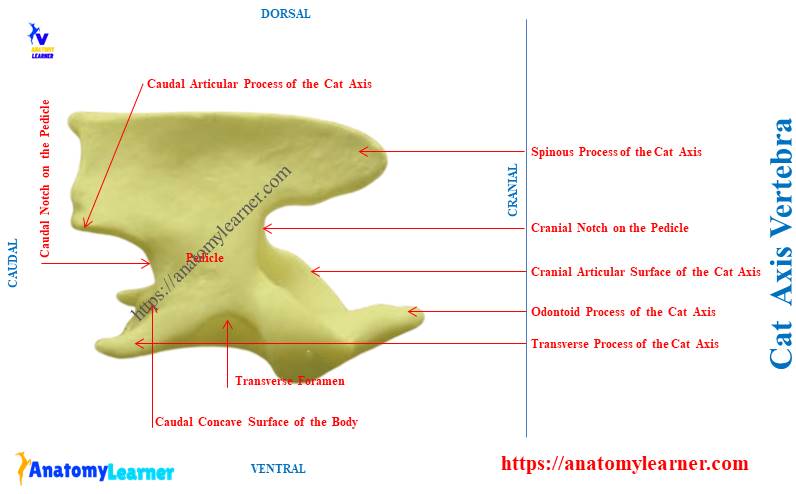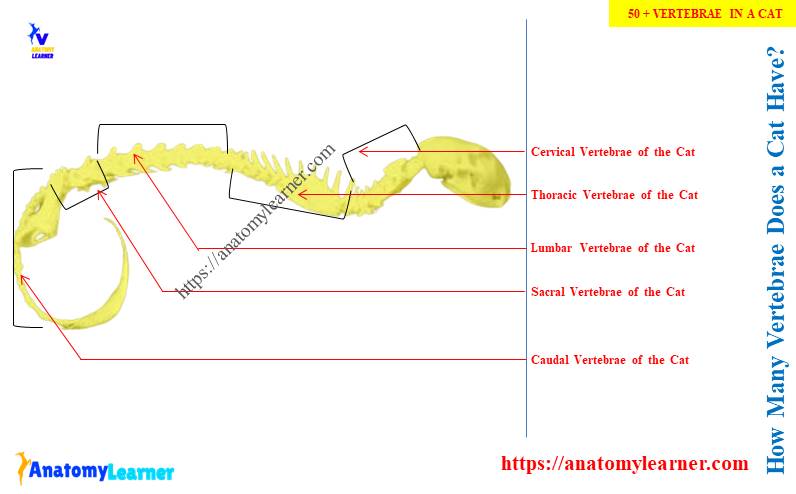The number of vertebrae varies within various cat breeds. Thus, you may have the question – how many vertebrae does a cat have?
Here, I will show you the ideal number of a cat’s vertebrae from its vertebral column with a diagram.
Quick answer: the cat has 49 – 55 vertebrae in its vertebral column. This variation occurs in the cat due to more or less the number of caudal vertebral bones.
The cat’s vertebral bones divide into 5 segments – cervical, thoracic, lumbar, sacral, and caudal. Except for the caudal vertebral bones, the cat has 30 bones in its vertebral column.
I will help you to identify each type of vertebral bone from the cat with their unique features. So, let’s know the number and features of each type of vertebrae from a cat’s skeleton.
How many vertebrae does a cat have?
The cat’s vertebrae are the series of articulated bones found in the midline of the body. They provide the main axial support to the cat’s body.
You will find these vertebral bones from the caudal aspect of the skull to the tail. They are irregular, unpaired, and short bones in the cat’s body.

Here, the cat’s vertebral column labeled diagram identifies the vertebrae from 5 different segments. Let’s see the various types of vertebrae with their number from Table 1 –
| Type of cat’s vertebrae | Cat vertebrae number |
| Cervical vertebrae | 7 |
| Thoracic vertebrae | 13 |
| Lumbar vertebrae | 7 |
| Sacral vertebrae | 3 |
| Caudal vertebrae | 20 (19 – 25) |
| Total vertebrae | 50 |
So, the cats have a total of 50 vertebrae. As the caudal vertebral bones are variable in different cats, the total number also may vary from 49 – 55.
Let’s find the detailed guide on the cat’s caudal vertebrae or tail bones from the article –
The number of the cervical, thoracic, lumbar, and sacral vertebrae in the cat’s skeleton is fixed. Here, the sacrum is a fused bone that consists of 3 vertebrae.
Thus, from the cervical to the sacrum, you will find 30 vertebrae in the cat’s axial skeleton.
The cervical vertebrae support the cat’s neck and also contain the cervical segment of the spinal cord. You will find the important role of the thoracic vertebrae in the cat’s rib-bearing region.
The vertebrae from the cat’s vertebral column shows two curvatures –
- A concave cervical-thoracic region anteriorly, and
- The convex thoracic-lumbar region posteriorly,
Thus, these vertebrae impart bowlike actions to the vertebral column during the cat’s locomotion.
What vertebrae do cats have?
The cats have 5 types of following vertebrae –
- Cervical vertebrae – 7 in the cats. And the first, second, and seventh show very distinct structures. The rest of the cat’s cervical vertebrae show the typical features.
- Thoracic vertebrae – they have longer spinous processes and unique small facets for the ribs,
- Lumbar vertebrae – they are 7 in number and are considered the larger vertebrae in the spine. You will see a longer transverse process in the cat’s lumbar vertebrae.
- Sacral vertebrae – they are 3 in number and fused to form the single sacrum bone and
- Caudal or coccygeal vertebrae – vary the number from 19 to 25 in various cats. Except for the first few vertebrae, they show the atypical features in the cat’s tail.
Cat vertebrae formula
You may express the number of cat vertebrae with the following formula –
C7T13L7S3C19-25
Here, C7 = seven cervical, T13 = thirteen thoracic, L7 = seven lumbar, S3 = three sacral, and C19-25 = caudal vertebrae.
So, when you express various types of vertebrae with their number, it is known as the vertebral formula. You may also know when you will call the vertebral column in a cat.
What is a vertebral column in a cat?
The cat’s vertebral column consists of a series of articulated vertebrae that differentiate into 5 groups. It is the long column of the cat that plays an important role during locomotion.
So, the vertebral column of a cat is part of the axial skeleton. It is also commonly known as the spine of the cat.
Let’s get the full guide on axial and appendicular skeletons of a cat from the below-mentioned article –
Here, the vertebral bodies and intervertebral discs form the solid rod. On this solid, the vertebral arches of the feline vertebrae are constructed.
Together, all these arches of the vertebrae form the hollow canal for the protection of the spinal cord. This hollow canal is also known as the spinal canal of the cats.
You will find two intervertebral foramina on both the right and left sides of two adjacent articulated vertebrae. Within this foramina, the spinal nerves and vessels of the cats pass.
Now, let’s count the number of specific vertebrae from various segments of the cat’s spine. I will enlist the unique features of these specific vertebrae from the cats.
Do cats have 7 cervical vertebrae?
Yes, the cats also have 7 cervical vertebrae like the other animals. Most of the mammals, including cats, dogs, cows, and giraffes, possess seven cervical vertebrae.
You will find specialization in these cervical vertebrae, but certain features are similar to all. Among the cat’s cervical vertebrae, the first two – atlas and axis are very distinctly structured.
To understand these distinct structures of the atlas and axis, you might know the typical features of a cervical vertebra. So, let’s see the standard features of the typical cervical vertebrae of cats.
Typical vertebra of a cat
Except for the first and second, the rest of the cervical vertebrae are under the typical vertebrae. A typical vertebra is constructed with a solid body (centrum).
This solid body of the cat’s typical vertebra forms the vertebral canal that supports the spinal cord. Again, this vertebral canal of a cat is completed by the dorsal pair of laminae and pair of pedicles.
The dorsocaudal extension of the laminae forms the spinous process in the cat vertebra. Again, the transverse process of the cat vertebra is formed in between the junction of the pedicel and body.
At the cranial end of each typical cervical vertebrae, you will find two articular processes. They are also known as prezygapophyses, whose articulating surfaces face dorsomedially.
The caudal end of each vertebra also possesses two caudal articular facets. They are known as the postzygapophyses, and their articular facets face ventromedially.
Thus, if you summarize the features of a cat’s typical cervical vertebra, you will see the following –
- Have a solid body or centrum,
- Possess dorsal laminae and ventral pedicle that form the arches and
- Have 3 processes – spinous, transverse, and articular,
You will see these features in the 3rd to 7th cervical vertebrae, with some notable exceptions. The length of the spinous process of the third cervical vertebra of a cat is short. But, the spinous process is gradually increasing from the fourth to seventh cervical vertebrae.
There is a transverse foramen in the cat seventh cervical vertebra. Again, you will see the caudal pair of facets on the body of the cat seventh cervical vertebra for the ribs.
The transverse process of the cat’s sixth cervical vertebra is bifurcated.
Cat atlas vertebra anatomy
The cat atlas vertebra is a ringlike structure that lacks a solid body. It also lacks a distinct spine but has a broad, winglike transverse process.
The cranial end of the cat atlas bears an inner articular surface. It accommodates the rounded articular surface of the skull’s occipital condyle.
The caudal extremity of the cat atlas does not possess the articular surface. However, it shows well-defined fovea dentis for articulation with the odontoid process of the cat axis.
The cat atlas shows the first intervertebral foramen (atlantal) through which the first spinal nerve and vein exist. You will also find the transverse foramen through the transverse process of the cat atlas.
There is no alar foramen in the cat atlas, but the alar notch is present. Through the transverse foramen, the vertebral arteries and veins pass.
The neural ring forms the part of the vertebral canal and contains the small artery along with the spinal cord. The small vertebral artery extends caudally along the ventral surface of the cat’s spinal cord.
The cat atlas labeled diagram shows the important osteological features. You may find more cat vertebra labeled diagrams here.
Cat axis vertebra anatomy
The cat axis vertebra looks like the blacksmith’s anvil. It possesses a pronounced spinous process compared to the other cervical vertebrae.
The arches of the cat axis possess both deep cranial and caudal notches. A distinct odontoid process is an important osteological feature of the cat axis vertebra.
The odontoid process of the cat axis is also known as the dens. A pair of cranial articular processes with smooth articulating surfaces are present above the dens.
These structures of the axis articulate with the fovea dentis of the cat’s atlas. Here, the odontoid process represents the body of the atlas that fuses with the body of the axis.
The transverse process of the cat axis vertebra is thin and caudally projected. You will find the larger transverse foramina in the transverse processes of the cat axis vertebra.
The caudal articular processes are present on the dorsal aspect of the arches. They have ventrally directed articulating facets.

Here, the diagram shows the various features of the cat axis bone. This video might help you to understand the important structures of the various vertebrae of animals.
Cat thoracic vertebrae
How many thoracic vertebrae does a cat have? Let’s count the thoracic vertebrae from the cat’s vertebral column –
Here, the cat’s vertebral column shows 13 thoracic vertebrae,
All the thoracic vertebrae of the cats are almost similar in their external features. You will not find more specialization in the cat’s thoracic vertebrae.
Following are the typical osteological features of the feline thoracic vertebrae –
- The spinous processes of the cat’s thoracic vertebrae are longer compared to other vertebrae,
- Two small transverse processes in the thoracic vertebrae possess small articular facets,
- Cranial and caudal demifacets occur in the body of the cat’s thoracic vertebrae,
- The body of the feline or cat’s thoracic vertebrae are longer and constricted at the middle,
- Two cranial articular processes are in the oval form and located on the dorsal lamina of the arches,
- The caudal articular facets (postzygapophysis) are located on the ventral end of the spinous process,
Why are feline thoracic vertebrae unique?
The articular facets on the transverse process and the body are exceptional in the feline thoracic vertebrae. You will see the articular facets on the ventral surface of the transverse process of the cat’s thoracic vertebrae.
This facet accommodates the tuberculum of the cat rib. Again, the cranial and caudal extremities of the body of a cat’s thoracic vertebrae possess small facets.
Two facets of two adjacent thoracic vertebrae form the demifacet. Within these demifacets the capitulum of the cat ribs articulates.
The spinous processes of the first 9 or 10 thoracic vertebrae are very distinct and elongated. They all possess a pointed caudal end dorsally.
The spine of the rest of the thoracic vertebrae makes an abrupt change in direction. They are known as the anticlinal vertebrae in the cat’s vertebral column. The spines of these vertebrae are pointed cranially.
The eleventh thoracic vertebra of a cat has a much reduced transverse process. Again, the twelve and thirteen thoracic vertebrae sometimes lack the transverse process.
Cat lumbar vertebrae number
The cats have 7 lumbar vertebrae in their vertebral column. These seven lumbar vertebrae of the feline spine are characterized as the largest bones of the spine.
Here, the diagram shows the seven lumbar vertebrae from the feline spine or vertebral column. The size of these lumbar vertebrae is increasing toward the caudal end of the series.
You will find the body, arches, and 3 major processes in the structure of the cat’s lumbar vertebral bones. Let’s see the most unique features of the feline lumbar vertebrae –
- These lumbar vertebrae of the cats have cranially projecting transverse process (pleuropophysis),
- The body of the feline lumbar vertebra is comparatively wider than others,
- You will find the cranially directed spinous process in the feline lumbar vertebrae,
- The cranial articular process of the cat’s lumbar vertebra faces dorsomedially and is little different than other species,
- There are toothlike projections (also known as accessory process) located ventral to the caudal articular process,
- Sometimes, the mammillary process may see to the lateral aspect of the cranial articular process,
The accessory process may be present in all the lumbar vertebrae of the feline. But, you will only find the mammillary process in the last two or three lumbar vertebrae of the cats.
Cat sacrum anatomy
You may easily differentiate the cat sacrum from the dogs and cows. Let’s know the details of the dog sacrum anatomy from the below-mentioned article –
Here, Table 2 shows the number of sacral vertebrae in the sacrum of various species –
| Animal’s sacrum | Sacral vertebrae in sacrum |
| Cat | 3 |
| Dog | 3 |
| Horse | 5 |
| Cow | 5 |
| Sheep | 4 |
| Goat | 5 |
| Pig | 4 |
| Rabbit | 4 |
So, the cat has 3 sacral vertebrae in its sacrum.
In the older cat, these three sacral vertebrae remain fused. But they remain as the separated bone in the kitten’s sacrum.
The cat sacrum is a roughly triangular bone that possesses all typical features like the dog’s sacrum. Three vertebrae of the cat’s sacrum bone decrease in size caudally.
The respective articular processes fused and form the single cranial and caudal distinct articular process. Here, the spinous process of these three sacral vertebrae fused to form the single median sacral crest.
You will also find two lateral crests in the cat sacrum. There are two pairs of dorsal and ventral sacral foramina in the structure of the cat sacrum.
You will find a significant difference in the sacrum wing of a cat compared to the dogs. The dogs have a high wing in their sacrum.
Here, I tried to show all the anatomical features of the cat sacrum with the labeled diagram. The diagram also shows the clear differentiation between the dog’s and cat’s sacrums.
How many vertebrae does a cat’s tail have?
The vertebrae of the cat’s tail are the smallest and most variable in the number. You may find variations in the number of a cat’s tail bones from 19 to 25.
The vertebrae of the cranial part of the cat’s tail exhibit the typical features of the vertebra. However, the caudal vertebrae of the feline tail have no typical features.
Here, the diagram shows the tail vertebrae of the feline. If you count these vertebrae, you will find 20 vertebrae in the tail.
The last few vertebrae of the tail lose their features and become more rod-shaped. Some of these tail vertebrae show two important features –
- Hemal process – on the ventral surface of the body of the tail vertebrae and
- Hemal arches – V-shaped structure on the ventral surface of the vertebral body,
Cat vertebrae diagram
Now, let’s see the various types of cat vertebrae from its spine. I tried to show you the 5 types of vertebrae from the cat’s skeleton with a diagram.
The diagram shows the fixed number of vertebrae in the cervical, thoracic, lumbar, and sacrum regions. Here, the cervical part of the cat’s spine shows great variation in their bones.
The 13 thoracic vertebrae with their longer spinous processes are identified in the cat’s spine labeled diagram. Again, the diagram identifies 7 lumbar vertebrae with their cranially directed transverse process.
A triangular sacrum with its external features is also identified in the cat sacrum labeled diagram. Twenty-one caudal vertebrae are identified from the cat’s tail with the labeled diagram.
Do cats have more vertebrae than other animals?
Cats have more vertebrae than dogs, pigs, and rabbits. However, the number varies in the cats due to the presence of more or less number of caudal vertebrae compared to others.
Let’s see the number of vertebrae from various animals in Table 3 –
| Animals | Cervical | Thoracic | Lumbar | Sacral | Caudal | Total |
| Dog | 7 | 13 | 7 | 3 | 19 – 24 | 49 – 54 |
| Cat | 7 | 13 | 7 | 3 | 19 – 25 | 49 – 55 |
| Pig | 7 | 14 | 6 | 4 | 15 – 19 | 46 – 50 |
| Rabbit | 7 | 12 | 6 | 4 | 12 – 15 | 41 – 44 |
| Cow | 7 | 13 | 6 | 5 | 15 – 18 | 46 – 49 |
| Horse | 7 | 18 | 6 | 5 | 16 – 21 | 52 – 57 |
So, the total number of vertebrae depends on the number of caudal vertebrae in each animal.
Conclusion
So, the answer to the question – how many vertebrae does a cat have was explained. On average, you will find 50 vertebrae in the structure of the cat’s vertebral column.
Compared to the other animals, the cats have more number of vertebrae as their tail possess more bones. All these vertebrae from the cat’s vertebral column are unique in their osteological features.

